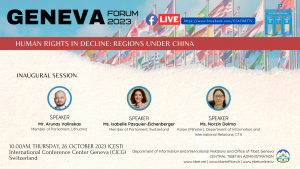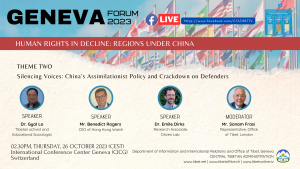The human rights situations in various regions under the PRC government’s control such as East Turkestan, Tibet, Southern Mongolia, and Hong Kong, have emerged as critical global issues, sparking profound concerns about the safeguarding of basic human rights. These regions, each marked by its unique cultural and political dynamics, have become focal points of concern due to reports of human rights abuses, political repression, cultural assimilation, and the erosion of autonomy over the decades. The implementation of policies such as the Second-generation Ethnic Policy, Zero-Covid policy, Second Generation Bilingual Education policy, suppression of any signs of dissent, including manifestations of religious beliefs and cultural identity has accelerated the sinicization of the Tibetans, Uyghurs, Southern Mongolians and others under Chinese occupation who are culturally different from the Chinese.
In 2022, the UN special rapporteur on contemporary forms of slavery, Tomoya Obokata, uncovered forced labor in East Turkestan, affecting Uighurs, Kazakhs, Kyrgyz, and other groups of peoples through state-mandated systems like vocational education center placements and transferring rural labor for poverty relief. Similar practices were found in the so-called Tibet Autonomous Region, pushing farmers, herders, and rural workers into low-wage jobs. The report suggested some cases could amount to enslavement and called for an independent investigation as a crime against humanity. These coerced labor efforts also compelled these peoples with their distinct cultural identities to assimilate into new environments, away from their traditional settings.
A report by a rights group monitoring the human rights situation in Tibet has characterized Tibet as a “Giant Open Prison.” This is reflected in successive reports by the Freedom House in their reports since 2021, ranking Tibet among the world’s least free nations, a ranking maintained in Freedom House’s Freedom in the World 2023 report. In 2022, due to China’s stringent zero-COVID policy in Tibet, Tibetans face increased surveillance and harsh consequences, with people in Lhasa being confined to stadiums, schools, and unfinished buildings. Protests against the lockdown, which had been in effect since August 8, began online in September and escalated to street demonstrations on October 27, with individuals across Tibet arrested for sharing COVID-related content online. As many as 94 Tibetans were known to have been unfairly detained and arrested by the Chinese authorities in 2022. Among them, Chinese courts sentenced 14 Tibetans to prison terms ranging from two to fourteen years on trumped-up charges of “inciting separatism”, “endangering state security”, and “leaking state secrets.” At least five Tibetan political prisoners are reported to have died as a result of torture in 2022. In 2021, two Tibetans, Tenzin Nyima, 19 and Kunchok Jinpa, 51, died after being severely beaten and tortured by the Chinese authorities during their detention. In some cases, Chinese authorities released Tibetan prisoners prematurely in near-death conditions to prevent deaths in prison. The true number of such cases is unknown due to extreme information control in Tibet.
In 2008, Tibetans from across Tibet protested against China’s rule over Tibet and called for the return of His Holiness the Dalai Lama. These protests were violently suppressed, resulting in the intensified implementation of a repressive surveillance system in Tibet. Since 2009, with limited space to express grievances, Tibetans have been compelled to take extreme forms of protest through self-immolation. So far, 157 Tibetans have self-immolated themselves to protest the Chinese government’s occupation and its oppressive policies in Tibet calling for freedom in Tibet and the return of His Holiness to the Dalai Lama.
In 2017, the Chinese government implemented “Deradicalization Regulations,” codifying efforts to “contain and eradicate extremism”. Since then, the government have used this broad definition of extremism to detain around 900,000 to 1.8 million Uyghurs, Kyrgyz, Kazakhs, and other predominantly Muslim people in high-security camps where human rights abuses, including torture and sexual assault, have been documented. In addition to the internment camp system, hundreds of thousands of individuals were subjected to prison sentences, as confirmed by the government, which reported that 540,826 people were prosecuted in the region between 2017 and 2022. In 2020, the Australian Strategic Policy Institute’s Xinjiang Data Project used satellite analysis to identify 385 detention centers in East Turkestan.
In May 2022, RFA reported that authorities detained approximately 30 teachers from one high school in Ghulja City in East Turkestan. Local authorities confirmed to RFA that most of the detained teachers had been sent to “re-education” centers but noted seven teachers were sentenced to prison. Local officials told RFA that they could not divulge the charges against the seven teachers because the details were “state secrets.” In September 2023, days leading up to China’s National Day holiday, authorities in East Turkestan apprehended over 50 Uyghur villagers from two communities, including those who were underage during the 2017 mass arrests of Uyghur Muslims and those who had evaded capture. Many political prisoners remained either in prison or under other forms of detention, including retired medical doctor Gulshan Abbas; entrepreneur Ekpar Asat, scholars such as Ilham Tohti, Hushtar Isa, and Rahile Dawut, who was recently sentenced to life imprisonment for her scholarly work by on charges of endangering state security.
The human rights situation in Southern Mongolia under China is equally dire. The people of Southern Mongolia live in fear of being arrested for openly criticizing the government, resulting in self-censorship and a lack of freedom of expression. This atmosphere of fear is fueled by instances of intimidation and over 10,000 arrests, detention, and imprisonment of those who opposed the 2020 school reforms. Authorities have even published lists of individuals suspected of “reprehensible behavior,” offering financial rewards for their arrest, indicating a severe clampdown on dissent and a disregard for human rights in the region. In May 2023, Lhamjab Borjigin, a Southern Mongolian historian, who had faced imprisonment and house arrest for criticizing the Cultural Revolution in his writings, was forcefully apprehended by Chinese authorities in Ulaanbaatar, months after he had escaped to Mongolia in March, making this the fifth case of deportation of Southern Mongols from Mongolia.
The human rights situation in Hong Kong has similarly been in decline over the last few years. Under the National Security Law and other repressive laws, increased and intensified crackdown on pro-democracy figures and legal action against independent media outlets have limited freedom of expression fostering a climate of fear and self-censorship sparking concerns about Hong Kong’s future. Despite China’s extensive surveillance at suppressing opposition and preventing any challenges to the authoritarian regime, the people of regions such as East Turkestan, Tibet, Southern Mongolia, and Hong Kong have displayed remarkable courage by risking their lives and everything they hold dear to speak out against numerous atrocities committed by the Chinese government.


